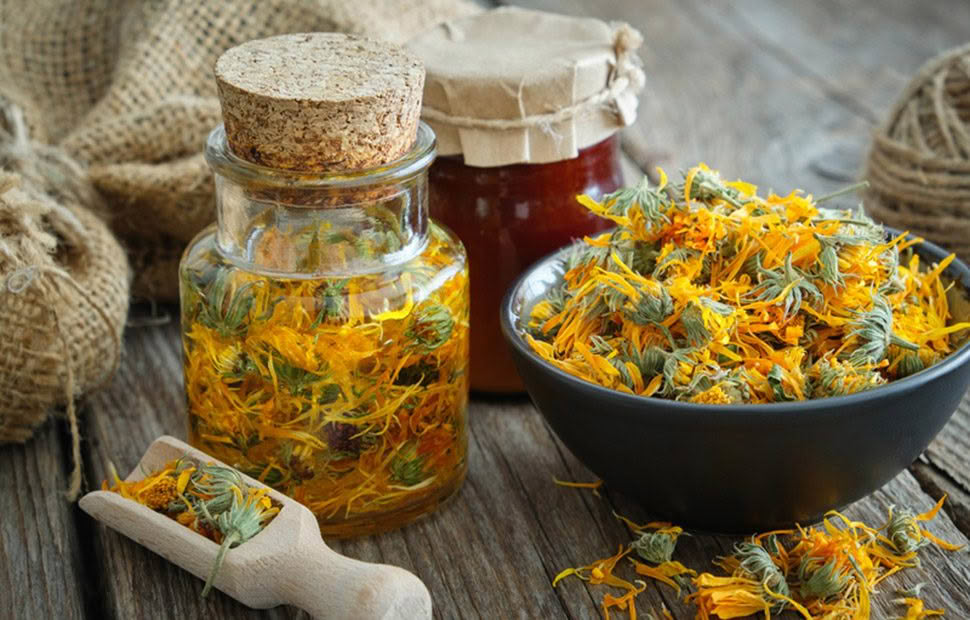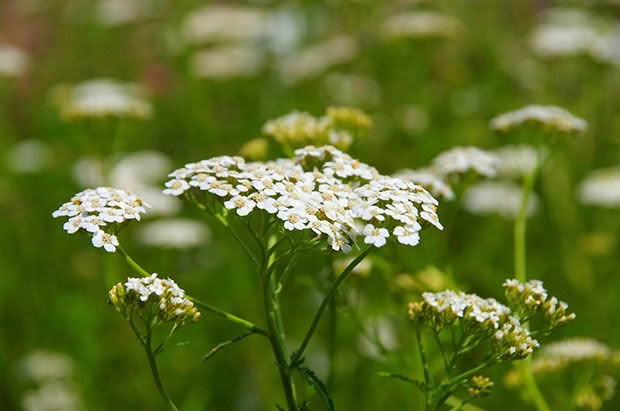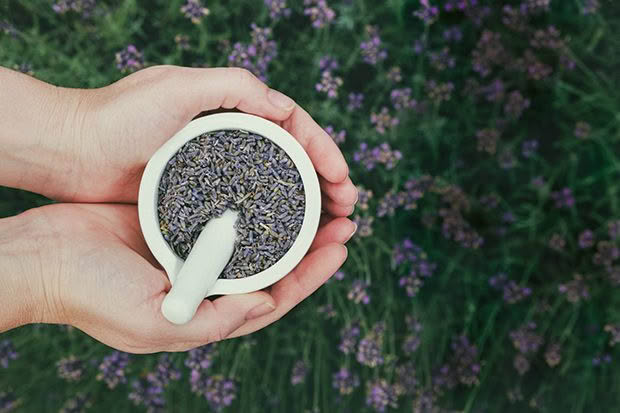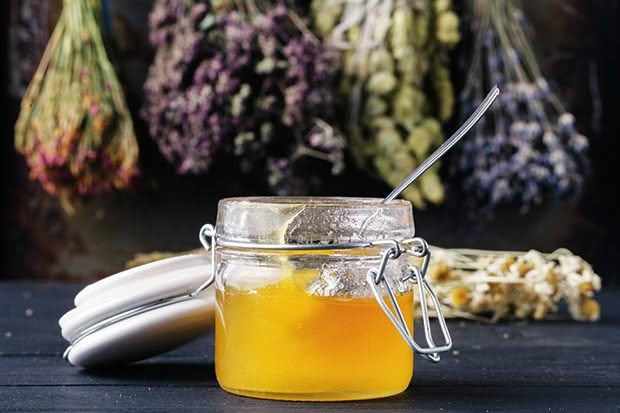Eight herbs for your first aid cabinet

From battlefield balms to itchy-skin ointments, your garden has everything you need to make a handy first aid kit.
Words: Jane Wrigglesworth
Take a look in your garden and chances are you have the makings of a first aid kit. Herbs and even weeds – although they cannot replace emergency medicine – can help soothe and promote the healing of minor cuts and scrapes, stings and itches, bruises, strains and sprains. Minor mishaps respond well to herbal treatments; here are a few standout plants worth growing to stay prepared.
YARROW
Even small cuts bleed a lot, which is where yarrow (Achillea millefolium) comes in handy. This perennial herb has been used for thousands of years for its ability to staunch the flow of blood. It’s anti-inflammatory, antimicrobial, astringent and styptic – it tightens tissue and stops bleeding. It’s notable for its use on historical battlefields, hence its common names: woundwort, bloodwort, sanguinary, nosebleed herb and knight’s milfoil.
For small cuts and scratches, grab some fresh leaves and bruise them by rubbing between your hands, or make a spit poultice by chewing the leaves in your mouth for a short while to release the juices. Pack the leaves onto the cleaned wound where they will help stop the bleeding. You can insert the leaves into your nostrils to stop nosebleeds. As the majority of bleeds come from the wall between the two nose channels just inside your nose, you don’t need to insert the herb too far.
As yarrow dies back in winter, harvest the flowers and leaves when in summer flower to dry for winter use. Once dried, powder the flowers and leaves and store in an airtight container. To use as a regular poultice, combine a pinch of yarrow powder with a few drops of water and apply to a minor wound.
Yarrow prefers full sun and free-draining soil. It flowers throughout summer through to early or mid-autumn, depending on where you live. Plants reach a height of up to 60cm.
Note: Yarrow may cause an allergic reaction in people who are sensitive to the Asteraceae/Compositae family so make sure you do your research or consult your primary healthcare provider if you have any concerns.

CHICKWEED
Chickweed (Stellaria media) is an annual weed that emerges in winter and early spring. It’s a highly nutritious plant, packed with an assortment of vitamins and minerals. If you can get past its weed status, you’ll find it very useful for relieving itchy skin. I use it in salves that can be used to soothe insect bites, rashes and inflamed skin. I often combine it with gotu kola (Centella asiatica), which is antibacterial, anti-inflammatory, analgesic, and is shown to speed up wound healing.
When making a salve, the first step is to infuse the leaves in oil (sweet almond oil or olive oil). Fill a clear glass jar two thirds of the way with dried chickweed leaves and top with oil. Screw the lid on tightly and place in a warm room out of direct sunlight. Turn the jar once a day to aid infusion. After four to six weeks, strain through a cheesecloth and store in an airtight container in a cool, dark location. When you’re ready to use it, apply the oil to itchy skin, or make a salve (use 100ml chickweed-infused oil and chamomile essential oil).
Note: Chickweed has a high water content, so ensure the leaves are dried properly if storing.
COMFREY
Comfrey (Symphytum officinale) is a great first aid option for sprains, strains and bruises. Its common names include knitbone, boneset and bruisewort in reference to one of its key constituents, allantoin, which is known to promote cell proliferation that helps to repair damaged tissue. It has significant anti-inflammatory properties too, due to the presence of rosmarinic acid and other phenolic acids.
Comfrey leaves are used topically in creams or as a compress or poultice. A poultice is a little bit messy and the hairs on the leaves and stems can be a skin irritant, so I tend to use comfrey-infused oil (made as per chickweed-infused oil instructions) to rub over the skin when needed.
Comfrey is a deep-rooted perennial so it’s best planted in a spot where its roots can burrow into the soil to a depth of about 1.5 metres. Plant it in an area where you can keep it under control, as it does spread rapidly. Comfrey grows in sun or part shade.
Cut leaves for drying when the plant is around 60cm high. As the plant is quick-growing, it will likely be ready for another cut around six weeks later.

CHAMOMILE
Chamomile is one of the world’s most popular herbs. It’s flower heads are well-known for their gentle healing properties, and have been used for many conditions such as digestive disorders, mild infections, and liver and gallbladder complaints. While it has antibacterial, antifungal, antiviral, and antispasmodic properties, it is best known for its use as a mild sedative. For stress, insomnia and frazzled nerves, a cup of chamomile tea is just the thing.
But while most of us might use it as a calming herb, its bigger claim to fame, in my opinion, is its anti-inflammatory properties. It’s fantastic at reducing inflammation and I use it mainly for this reason. If you have gastritis or stomach cramps, for example, sipping chamomile tea throughout the day can ease discomfort. I also find it useful to apply to small wounds and frequently make a soothing herbal honey for this purpose.
The annual German chamomile (Matricaria recutita) is the one to use. It thrives in full sun but will grow in light shade. Sow the seeds in late winter or early spring in trays or small pots for transplanting when large enough. As the seed is tiny, just firm them down into a moist bed and thin seedlings to 15cm.
PLANTAIN
Both broadleaf plantain (Plantago major) and narrow leaf plantain (Plantago lanceolata – aka ribwort) contain compounds that are anti-inflammatory, antibacterial and aid wound healing. The leaves can be applied directly to small wounds and mild burns to soothe pain and help to repair tissue. Yes, they are classed as weeds, but the leaves are useful for halting the sting and itchiness of insect bites and rashes. This is a great herb for bites, scratches and plant stings when out and about tramping or away from home, although avoid foraging them in places that have been sprayed or exposed to poisons.
A cool compress with a clean flannel dipped into a strong plantain tea works well. Or make a spit poultice by briefly chewing a fresh leaf to release its juices and placing it onto the affected area.
Teas, syrups and tinctures made from the leaves are useful for coughs as well.
FEVERFEW
Feverfew (Tanacetum parthenium) is commonly used as a preventative for migraines. Several attendees of the herb talks I give have attested to its effectiveness. The leaves are consumed raw as a preventative (two or three leaves daily) or eaten at the very start of a migraine. They can be poked into sandwiches, added to smoothies or salads, or made into a tincture.
To make your own feverfew tincture, fill a glass jar with feverfew leaves, top with 80-proof vodka, and steep for four to six weeks, turning once a day. Strain and decant into a clean jar, or several dropper bottles.
Take a few drops daily, or as needed.
Feverfew is a hardy perennial that flowers for many months of the year. It self-sows readily, so you often find new plants in new spots of the garden. Grow in a sunny spot in free-draining soil. Plants are drought tolerant and need little maintenance, except perhaps a clip or deadhead every now and then to keep them tidy.
Note: Feverfew should not be consumed during pregnancy.
HONEY
Honey is antibacterial with wound-healing properties and is the perfect complement to herbal teas and remedies. For most honey, the antibacterial action is largely due to the enzymatic generation of hydrogen peroxide, although the levels can vary between honey samples and may be affected by commercial processing procedures. Mānuka honey, in particular, has significant antibacterial properties. Produced by certain Leptospermum species, the antibacterial activity of manuka honey correlates to its Unique Mānuka Factor (UMF) rating, which in turn correlates to the methylglyoxal (MGO) and total phenols present. In other words, although you can use any honey, high UMF manuka honey is the best. Medical grade honey is used in hospitals for wound and burn healing.
CALENDULA
I put calendula (Calendula officinalis) on just about everything. It’s an exceptional herb for skin issues, with anti-inflammatory, antimicrobial, astringent and vulnerary, or wound-healing, properties. Studies show that the constituents of the flower stimulate the growth of new tissues and blood vessels when applied externally to minor wounds, so it’s useful for scrapes, cuts, insect bites, stings, rashes, bruises, and inflamed skin.
My father can testify to its effectiveness. When digging in my garden, he unexpectedly came across a wasp nest and was stung by two or three wasps. I applied some vinegar first off, which did nothing, but then
I remembered I had some calendula salve. I applied this and the sting was gone within five minutes. Now, I use calendula salve for just about everything to do with the skin, including mosquito bites and rashes.
Calendula grows best in my garden in the cooler months of spring and autumn. It grows in summer, but I’ve noticed the flowers are fewer. In cooler regions you might be lucky to have the plant flowering consistently from spring through winter.
Calendula likes full sun and free-draining soil. Don’t provide too much nitrogen or you’ll get more leaves than flowers. It’s the flowers that you want for their medicinal value; harvest when fully open.
Make a calendula oil by infusing the dried flowers (petals or whole heads) in oil, as per chickweed oil infusion. Use as is on skin, or make a salve
Note: Calendula may cause an allergic reaction in people who are sensitive to the Asteraceae/Compositae family so make sure you do your research or consult your primary healthcare provider if you have any concerns.

LAVENDER
Lavender not only has calming effects; it has anti-inflammatory, antioxidant, antimicrobial and analgesic properties, and has been found to accelerate wound healing. A 1992 study of 100 patients in an intensive care unit who had lavender oil massaged into the feet found they had a significant reduction in blood pressure, heart rate and pain. And a clinical trial published in the European Journal of Neurology (2012) reported that patients suffering from migraines had significant reduction of pain after 15 minutes’ inhalation of lavender essential oil (two to three drops of essential oil rubbed onto their upper lip) in the early stages of the migraines.
At home, it’s easy to make a lavender-infused oil to rub on mild burns and other sore spots, or the soles of aching feet.
Alternatively, try a cooling compress: make a strong lavender tea, dip a flannel or piece of cotton into the cooled liquid and apply to inflamed or sunburned skin. You can also mix it with cold chamomile tea – also an anti-inflammatory – and aloe vera gel, stripped from the aloe plant’s inner leaves, for added benefit.
The English lavenders (Lavandula angustifolia) and lavandins (L. x intermedia) are the varieties most often used medicinally. They are also the most hardy of all the lavenders, though both succumb easily to pests and diseases in areas where humidity is high. Space plants out to ensure good airflow to reduce any chance of disease. Good drainage is also important.
Harvest the flowers and dry for use in lavender-infused oil.
Basic salve recipe
This mix will harden in winter, so I recommend using slightly less beeswax if applying over the cooler months.
INGREDIENTS
15g beeswax, roughly chopped or grated
100ml herb-infused oil (one herb or a mix of two)
20 drops essential oil
METHOD
Place beeswax and herb-infused oil in a double boiler and heat on low until the beeswax is melted.
Remove from the heat and add the essential oil, mixing well.
Pour into small, clean, dry jars or tins and allow to cool completely before placing the caps on the jars. Store in a cool, dark spot. Apply directly onto minor wounds or irritated areas when needed.

Wound healing honey
INGREDIENTS
30g dried chamomile
30g dried lavender flowers
30g dried plantain
300g raw honey
METHOD
Place herbs in a food processor or mortar and pestle and process or grind until they’re the consistency of fine breadcrumbs.
Tip the powdered herbs into a clean glass jar and pour over the honey.
Leave the jar in a warm room out of direct sunlight for three to four weeks. Turn the jar over once a day to enhance infusion. Apply directly onto minor wounds when needed.
Love this story? Subscribe now!
 This article first appeared in NZ Lifestyle Block Magazine.
This article first appeared in NZ Lifestyle Block Magazine.
